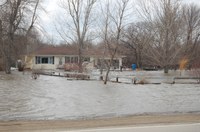Be Prepared for Flooding in Rural Areas
(Click the image below to view a high-resolution image that can be downloaded)
Have a plan to “shelter in place” if roads become impassable, says Ken Hellevang, a North Dakota State University Extension Service agricultural engineer and flood expert. The shelter should have everything needed, such as communication devices, food, water, electricity, fuel, medical kit and emergency transportation.
Hellevang also has this advice:
- Assemble supplies, such as water and food, that don’t require refrigeration or cooking. Have a battery-powered flashlight and radio, plus extra batteries in case the electricity goes off.
- Have an emergency power source such as a standby generator. This is critical if you have livestock confinement buildings that need ventilation.
- Move or prepare to move important documents.
- Take steps to reduce the chance of contaminants entering your well. If the well likely will be affected by the flood, turn off the electrical power to the well and seal it by installing a watertight cap or cover. If you don't have time to install a watertight cap, cover the top of the well with heavy plastic sheeting and secure it with electrical or strapping tape or some other type of waterproof taping material. Don't use duct tape because it is not waterproof.
- If your septic system’s drain field may be flooded or saturated, plug all basement drains and drastically reduce water use in the house. Don’t run water from a basement sump pump into the septic system or let water from roof gutters or the sump pump discharge into the drain field.
- Plug floor drains if flooding is occurring next to the house because water can flow back through the septic system. Unbolt toilets from the floor and plug the outlet pipe, shower drains, washing machine and basement sink drain.
- Move machinery, feed, grain, fuel and agricultural chemicals, such as pesticides and herbicides, to higher ground.
- Move motors and portable electric equipment to a dry location if possible.
- Anchor fuel and other tanks to keep them from moving with the floodwaters. Floating propane tanks are a common problem during floods. Identify large tanks with your name and address so they can be returned if they become displaced.
- Determine whether underground tanks are engineered to keep them from lifting out of the ground if the contents are lighter than water.
- Turn off electrical power to all buildings that could flood.
- Keep an inventory of livestock and property such as machinery and equipment. Also, prepare a list of hazardous or potentially hazardous substances.
- Move livestock to higher ground and be sure you have access to feed.
- If you have dairy cattle, develop plans for moving your cows to temporary milking facilities and learn about emergency milk pick-up services available in your area.
- Place riprap on the banks of earthen manure storage areas where flowing water may erode berms.
“Also develop an evacuation plan and a kit containing medicine, money, documents and other items that can be grabbed during an emergency evacuation,” Hellevang says. “These items could be missed in the chaos of an evacuation if not prepared in advance.”
NDSU Agriculture Communication - April 22, 2013
| Source: | Kenneth Hellevang, (701) 231-7243, kenneth.hellevang@ndsu.edu |
|---|---|
| Editor: | Rich Mattern, (701-231-6136, richard.mattern@ndsu.edu |


